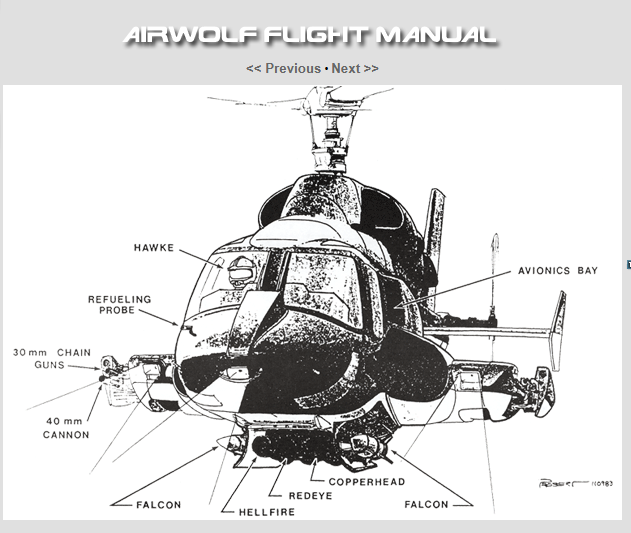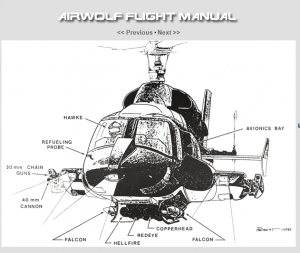We found this video giving more information about the Bell 222 helicopter, the model used for Airwolf:
From the description:
Explore the amazing Bell 222A Helicopter as you’ve never seen before. This is the first episode in an exclusive Helix av mini-series where we get under the skin of our very own ‘Wolfie’. Join us and really get to know this wonderful aircraft up close and personal.
Here is the official YouTube channel for this video: https://www.youtube.com/@HelixAvBell
According to YouTube, here is the transcript (wording and spelling errors included):
hello and welcome back to the Helix
Channel now those of you that may have
just recently watched our Bell 429 video
you may have wondered like we did where
did the 429 come from we’ve obviously
done the 505 came from the 206. we’ve
done the 407 came from the Long Ranger
but actually 49 came from this no Triple
this is our one you need this one which
is a bell treble two a now this is as
you can see painted like Airwolf clearly
it’s not the original werewolf that
sadly is no longer with us has no guns
obviously disappointing but it is a
representation of exactly what Airwolf
was so a few facts about the treble two
that you may or may not know
treble two was Belle’s first civilian
production light medium twin helicopter
it then went on to become the trouble 2B
the 230 the 430 47 and up to the 429
I’m just going to point out a few little
characteristics about the Trouble 2 we
are going to do a pre-flight video and a
startup video which is I’m sure the one
that everybody wants to see this sponsor
on the side is quite interesting it’s an
error 4 design so it does actually
produce a bit of lift during flight this
one is a retractable undercarriage
dribble too there was also a fixed
undercarriage which was the UT the spots
on the side actually houses Fuel and
obviously somewhere for the
undercarriers to go double two is also a
first in terms of its hydraulic system
that it had the electrics the autopilot
but we can’t really talk about the
Trouble 2 without mentioning the road
ahead now the head is a derivative of
and the blade you have to notice that
wide cord blade which gives the trouble
to its characteristic sound it’s a 39
foot diameter rotor system so it’s two
big wide blades which was the design at
the time then as we know blades went
into a more formated five bladed
as a nodal beam system very similar to
The Long Ranger so it is actually a very
smooth aircraft for a two blader and it
will get up to around 150 knots where it
does get a little lumpy at that end but
it’s too rated is powered by two
Lycoming LTS 101 engines they’re around
about 600 shaft horsepower each there
are two fueling systems on it this is
the main tank on this side and we have
an auxiliary tank on the port side good
size boot for the day as well
sadly this one doesn’t have its carpet
in today because this actual trouble too
isn’t serviceable as of today but we’re
going to get on to that but it was a
good size boot for the day you know
large aircraft needs a large boot as we
you’ll also see some design
characteristics down here now these end
plates were a late addition for the
Triple Two its initial design it had a
detail like a Hues 500e these are added
later if you look at the design of it
now you can see these very resembled a
407 and the 429 again moving rearwards
you can see a lot of 206 407 design cues
all the way through large rear fin to
assist with stability in the cruise
continue on round to the tail rotor as I
said earlier in the video we’re going to
do a pre-flight video we’ll get a bit
more into the depth on the tail rotor
but you can see it’s a typical Bell
two-bladed teetering system
but just look at the size of the cord
and put my hand against it you know
that’s larger than some main rotor
blades on other helicopters a few other
interesting facts about the treble two
they came out the factory around five
thousand pounds empty weight and gross
was eight thousand one hundred so pretty
good figures for sort of back in the
early 80s but what we should really have
a look at now is the inside a few years
ago I was talking to one of the older
engineers at Bell who said it’s an
unpleasant subject as we all seem to
touch on in our videos but if you were
going to have a crash have it in a
trouble too because the rigidity of the
shell is so strong one of the reasons
that I’ll show you just here as we go
doors it’s compared to a modern aircraft
they’re huge and they’re slam shot doors
that sounds like more like a car door
than a helicopter door but that gave it
great strength which was a great feature
of the uh the trouble two in the day
just before we climb in worth pointing
out 1981 helicopter double glazed
one of the features of the Triple Two
was that you could or can sit in the
it’s not silent but it’s quite enough
that you can have a conversation with
our headsets on also the huge amount of
room now on the 430 they stretch the
cabin even further and the early uh the
treble twos the seating could be
configured for up to eight passengers in
the back that would be quite cozy but
this is really where it was suited for
smooth ride cabin call for the front for
the pilot what else would you need
now it wouldn’t be one of our videos if
we didn’t have a look in the front my
favorite part of the cockpit so let’s go
and take a look now shall we okay our
couple of interesting facts about the
Trouble 2 because it’s many uh they made
82 of the treble two A’s which this
model is and 199 in total were produced
also came equipped as this one has with
weather radar which is in the front
which again we’ll touch on more when we
do the pre-clock video let’s get in the
so first thing you’re going to notice is
everything that we’ve said we’ve changed
which we now prefer is all in here huge
instrument panel the visibility is okay
but there’s still a lot of obscurity
here and lots and lots of steam gauges
this is a busy cockpit but it’s got a
bit of charm about it really
but one of the things that’s really
different is this Collective a normal
Collective as we know comes out the
floor a pole in your hand here this one
is a completely different design
throttles are in get on the side here
and your first flight and it’s a little
strange but actually you do get used to
it and it’s actually quite a nice
position for the collective
again up ahead like we’ve spoken on all
our previous videos on the 505 the 407
and the 429 no circuit breakers on here
there is an array of them and you really
do realize how far things have come
forward now because there’s an awful lot
going on here of switches circuit
breakers lights there’s a caution panel
here which is off of this button here
there’s another one you press down here
to get lights to come on down here
it’s a very busy cockpit but it is still
kind of cool and there’s some
differences that are also similar on the
four one two the two one two on our
torque meter we have a mast torque meter
and we have one needle for each engine
as well so three needles to monitor us
again so we keep going back to glass
cockpit easier to manage less to look at
so although a lot of old-school charm
so another interesting fact about the
Triple Two it’s going to be the video of
glass windshield heated as well or part
of the certification process as we said
earlier there will be two other videos
PreFlight and startup on the startup
video we’ll spend a fair bit of time in
the cockpit I’ll go through all the
switches the buttons the old pilots all
the lights you’ll really enjoy seeing
what’s our Takeaway on treble to then my
personal opinion I think it’s a
phenomenal designer a really pretty
helicopter but did you know you can
still get brand new parts for a triple
two from Bell today so when you buy a
brand new bell that’s what you’re buying
into the support is unrivaled and we
have moved a long way forward with the
429 the 407 and the 505 clean cockpits
glass no circuit breakers is the way to
be but it does take you back here the
pilots were in a busy environment back
in the day with all those switches and
phenomenal helicopter join us next time
Thanks:
one, two, three, four, five, six, seven, eight, nine, ten, eleven

